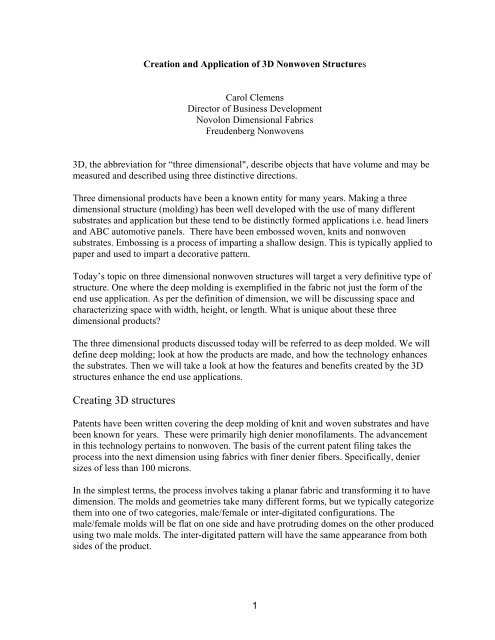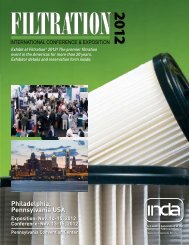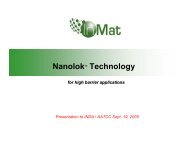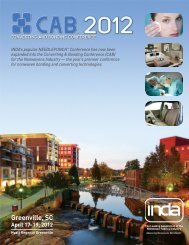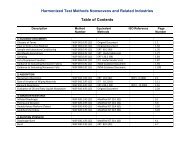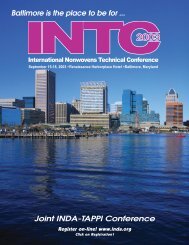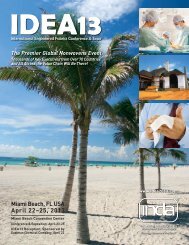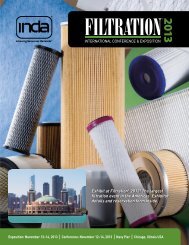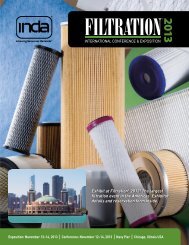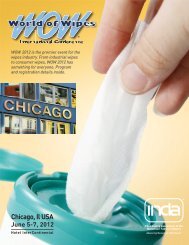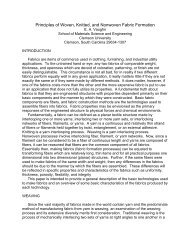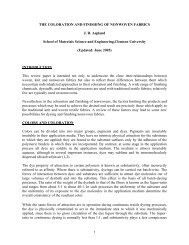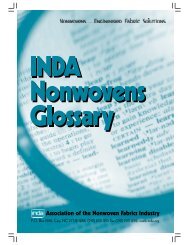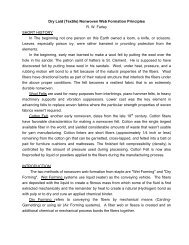Creation and Application of 3D Nonwoven Structures - INDA
Creation and Application of 3D Nonwoven Structures - INDA
Creation and Application of 3D Nonwoven Structures - INDA
Create successful ePaper yourself
Turn your PDF publications into a flip-book with our unique Google optimized e-Paper software.
<strong>Creation</strong> <strong>and</strong> <strong>Application</strong> <strong>of</strong> <strong>3D</strong> <strong>Nonwoven</strong> <strong>Structures</strong><br />
Carol Clemens<br />
Director <strong>of</strong> Business Development<br />
Novolon Dimensional Fabrics<br />
Freudenberg <strong>Nonwoven</strong>s<br />
<strong>3D</strong>, the abbreviation for “three dimensional", describe objects that have volume <strong>and</strong> may be<br />
measured <strong>and</strong> described using three distinctive directions.<br />
Three dimensional products have been a known entity for many years. Making a three<br />
dimensional structure (molding) has been well developed with the use <strong>of</strong> many different<br />
substrates <strong>and</strong> application but these tend to be distinctly formed applications i.e. head liners<br />
<strong>and</strong> ABC automotive panels. There have been embossed woven, knits <strong>and</strong> nonwoven<br />
substrates. Embossing is a process <strong>of</strong> imparting a shallow design. This is typically applied to<br />
paper <strong>and</strong> used to impart a decorative pattern.<br />
Today’s topic on three dimensional nonwoven structures will target a very definitive type <strong>of</strong><br />
structure. One where the deep molding is exemplified in the fabric not just the form <strong>of</strong> the<br />
end use application. As per the definition <strong>of</strong> dimension, we will be discussing space <strong>and</strong><br />
characterizing space with width, height, or length. What is unique about these three<br />
dimensional products<br />
The three dimensional products discussed today will be referred to as deep molded. We will<br />
define deep molding; look at how the products are made, <strong>and</strong> how the technology enhances<br />
the substrates. Then we will take a look at how the features <strong>and</strong> benefits created by the <strong>3D</strong><br />
structures enhance the end use applications.<br />
Creating <strong>3D</strong> structures<br />
Patents have been written covering the deep molding <strong>of</strong> knit <strong>and</strong> woven substrates <strong>and</strong> have<br />
been known for years. These were primarily high denier mon<strong>of</strong>ilaments. The advancement<br />
in this technology pertains to nonwoven. The basis <strong>of</strong> the current patent filing takes the<br />
process into the next dimension using fabrics with finer denier fibers. Specifically, denier<br />
sizes <strong>of</strong> less than 100 microns.<br />
In the simplest terms, the process involves taking a planar fabric <strong>and</strong> transforming it to have<br />
dimension. The molds <strong>and</strong> geometries take many different forms, but we typically categorize<br />
them into one <strong>of</strong> two categories, male/female or inter-digitated configurations. The<br />
male/female molds will be flat on one side <strong>and</strong> have protruding domes on the other produced<br />
using two male molds. The inter-digitated pattern will have the same appearance from both<br />
sides <strong>of</strong> the product.<br />
1
Male/ Female Side View<br />
Inter-digitated Side View<br />
The height <strong>of</strong> the dome can range between 1-50mm <strong>and</strong> the width <strong>of</strong> the dome up to 100mm.<br />
The process involves the application <strong>of</strong> heat, pressure <strong>and</strong> time to create the deep molded<br />
substrate. The molding process can be achieved through platen presses, or a calendar<br />
molding process.<br />
The Process<br />
Platen<br />
Planar<br />
Male/Female Mold<br />
Male/Female Mold<br />
Formed product<br />
Heating<br />
Molding<br />
Cooling<br />
Continuous<br />
Formed product<br />
Heating<br />
The selection <strong>of</strong> a nonwoven substrate does have some critical requirements. The fiber<br />
content must have a relatively high percentage <strong>of</strong> thermoplastic materials. The fibers can be<br />
in filament or staple form, with each producing their own unique properties. The array <strong>of</strong><br />
fibers successfully deep molded is broad <strong>and</strong> includes polyester, polyamide, polypropylene,<br />
polyolefin’s <strong>and</strong> more. These can be sheath/core, tri-lobal, segmented pie or any <strong>of</strong> the<br />
component fiber constructions.<br />
The ideally formed substrate would be a nonwoven fleece made <strong>of</strong> r<strong>and</strong>omized thermoplastic<br />
fibers. The more r<strong>and</strong>omized the fiber orientation the better. The process elongates the fibers<br />
when exposed to the correct temperatures. As a result, it is important to use fibers that have<br />
not been fully drawn. This will allow the fiber to form to the desired pattern without<br />
2
producing holes in the fabric. This also ensures better performance <strong>and</strong> maintenance <strong>of</strong> the<br />
domes over the life <strong>of</strong> the products. Crimped fibers also aid in producing well formed domes<br />
structures.<br />
Not all nonwovens can be molded.<br />
Draw ratios <strong>of</strong> up to 200% can be achieved in some fabrics. The draw ratio is the area <strong>of</strong> the<br />
molded substrate over the area <strong>of</strong> the unmolded substrate. The draw ratio is dependent upon<br />
fiber size, fabric weight, mold pattern <strong>and</strong> the fabric formation.<br />
The temperatures required to obtain a stable mold will vary depending upon the fibers being<br />
molded but must fall between the fiber’s glass transition point <strong>and</strong> the melt point <strong>of</strong> the fiber.<br />
This process enables us to retain a textile h<strong>and</strong>, <strong>and</strong> maintain the original functionality <strong>of</strong> the<br />
fabric.<br />
S<br />
If stiffness (more resistance to compression) is a requirement, this can be imparted with<br />
larger diameter fibers.<br />
Stiffness<br />
Relative Stiffness<br />
1000000<br />
100000<br />
10000<br />
1000<br />
100<br />
10<br />
1<br />
0.1<br />
0.01<br />
0.001<br />
0.0001<br />
0.00001<br />
0.000001<br />
Mon<strong>of</strong>ilament<br />
Deep Molded <strong>Nonwoven</strong>s<br />
Industrial Fabrics<br />
Textiles<br />
1 10 100 1000 10000<br />
Total Denier<br />
3
Dome size <strong>and</strong> weight also impacts the stiffness <strong>of</strong> the ultimate product.<br />
Effect <strong>of</strong> mold pattern<br />
3<br />
2.5<br />
Compression stress<br />
2<br />
1.5<br />
1<br />
0.5<br />
0<br />
EV80 EV100 EV130 EV170<br />
Spunbond<br />
180g<br />
1/8" Inter-digitated<br />
1/4" M/F<br />
3/8" M/F<br />
Substrates<br />
This chart illustrates that compression stress increases significantly when the mold pattern is<br />
increased from ¼” to 3/8” (M/F mold). Weight also plays a role but not as significantly.<br />
Multiple substrates can be used to build a composite providing the essential performance<br />
requirements. When two <strong>of</strong> the same substrates are married, the compression performance<br />
increases significantly. Nesting the substrates verses stacking the substrates also provides<br />
changes the compression performance.<br />
4
Compression Properties (psi)<br />
180g Spunbond<br />
2<br />
1.8<br />
1.6<br />
1.4<br />
1.2<br />
1<br />
0.8<br />
0.6<br />
0.4<br />
0.2<br />
0<br />
Single Layer Nested Dome-to-dome<br />
<strong>Application</strong>s<br />
A logical application for this type <strong>of</strong> product is in place <strong>of</strong> foam. A comparison between<br />
deep molded products <strong>and</strong> foam tells a very interesting story.<br />
• The deep molded substrate can have up to 75 times greater air permeability than<br />
foam.<br />
• It is roughly ½ the weight <strong>of</strong> foam while still maintaining the same compression level.<br />
• It is less flammable than urethane foams.<br />
• Recyclable<br />
• 1000 time the tear strength.<br />
This technology <strong>of</strong>fers a rebirth to many products. The process will enhance the performance<br />
<strong>of</strong> the end use application in addition to increasing its value. Certain qualities become<br />
inherent in deep molded substrates because <strong>of</strong> the geometries. By creating space, air<br />
circulation is increased. This, in turn, introduces the ability to manage heat <strong>and</strong> moisture.<br />
This is appealing for medical application such bedding <strong>and</strong> wound care.<br />
The increased surface area improves moisture <strong>and</strong> particle pickup in industrial <strong>and</strong> household<br />
products. This can mean the life for the product is extended or the manufacturer doesn’t have<br />
to sell as large <strong>of</strong> the product to get the job done.<br />
5
With a more rigid substrate, the product can deflect the force <strong>of</strong> impact; very appealing for<br />
products such as bullet pro<strong>of</strong> vests. The protective garment is also more comfortable because<br />
it sits <strong>of</strong>f the body, allowing greater air flow.<br />
Space also provides the opportunity to insert circuitry. Automotive seating has become very<br />
sophisticated, requiring a lot <strong>of</strong> circuitry to be imbedded in the seat. The deep molded<br />
product not only makes this process easier but improves the comfort <strong>and</strong> functionality <strong>of</strong> the<br />
product.<br />
There are many other applications where the deep molded products provide important<br />
performance <strong>and</strong> aesthetics characteristic. Some are noted below including:<br />
• Outdoor equipment<br />
• Filtration<br />
• Acoustical applications<br />
• Construction<br />
• Clothing<br />
The list is very lengthy <strong>and</strong> is only limited by the imagination.<br />
This technology has created <strong>and</strong> will continue to create tremendous opportunities for the<br />
nonwoven market. With the right combination <strong>of</strong> polymers, fiber, construction <strong>and</strong> mold<br />
geometries, the possibilities are never ending.<br />
The research performed to support this paper <strong>and</strong> for the development <strong>of</strong> the technology is<br />
collaborative effort <strong>of</strong> the University <strong>of</strong> North Carolina <strong>and</strong> Freudenberg North America.<br />
I wanted to acknowledge some key individuals who enabled this process to become reality.<br />
• Dr. Behnam Pourdeyhimi, Associate Dean <strong>of</strong> Textiles @ NCSU, inventor <strong>of</strong> this<br />
nonwoven technology.<br />
• Mr. Walter Schwarz, President <strong>of</strong> Freudenberg <strong>Nonwoven</strong>s North America for having<br />
the vision to support this endeavor.<br />
• Dr Walter Chappas, General Manager <strong>of</strong> Novolon Dimensional Fabrics for his<br />
enthusiasm <strong>and</strong> spirit to create a business out <strong>of</strong> this technology.<br />
6
<strong>Creation</strong> <strong>and</strong> <strong>Application</strong> <strong>of</strong> <strong>3D</strong> <strong>Nonwoven</strong><br />
<strong>Structures</strong><br />
Novolon Dimensional<br />
Fabrics<br />
1
There are other <strong>3D</strong> structures.<br />
• Most <strong>of</strong> the known <strong>3D</strong> structures are made to fit<br />
a space <strong>and</strong> form specific to the application,<br />
(headliners, automotive carpets)<br />
• There is little to no recovery after elongation.<br />
• Honeycomb structure made from knits <strong>and</strong><br />
woven materials are not possible with<br />
nonwovens.<br />
• Embossing provides a shallow dimension.<br />
Attaining structures with any depth results in<br />
punctures in the substrate.<br />
2
LENGTH<br />
Male / Female<br />
3
Substrates<br />
Mon<strong>of</strong>ilame<br />
nt<br />
<strong>Nonwoven</strong><br />
micr<strong>of</strong>iber<br />
Spunbo<br />
nd<br />
4
Typical Geometries<br />
Top View<br />
Dome Height<br />
Side View – Male/Female<br />
Side View – Inter-digitated<br />
5
Basic mold patterns<br />
Interdigitat<br />
ed<br />
Dome heights range up<br />
to 50mm<br />
Dome widths up to<br />
Male /<br />
Female<br />
6
The creation <strong>of</strong> a <strong>3D</strong> structure<br />
Planar Fabric (thermoplastic component)<br />
+ Heat (between glass transition <strong>and</strong> melt point)<br />
+ Pressure (mechanical deformation)<br />
+ Time<br />
= <strong>3D</strong> substrate<br />
7
The process<br />
Platen<br />
Substrate<br />
Planar<br />
Substrate<br />
Male/Female Mold<br />
Male/Female Mold<br />
Formed product<br />
Heating<br />
Molding<br />
Cooling<br />
Continuous<br />
Formed product<br />
Heating<br />
8
How is it done<br />
• If molded independently, the use <strong>of</strong> thermoplastic<br />
fibers that have not been fully drawn, produces the<br />
best results.<br />
• <strong>Nonwoven</strong>s made from fibers <strong>of</strong> any size can be deep<br />
molded.<br />
• Ideally, the structure is isotropic, with f p between - ½<br />
<strong>and</strong> ½.<br />
• The presence <strong>of</strong> crimp improves the mold-ability.<br />
• Composite substrates can be designed to provide the<br />
ultimate performance characteristics.<br />
9
<strong>Nonwoven</strong> Substrate Requirements<br />
• Most nonwovens cannot be<br />
molded<br />
• Ability to be drawn locally<br />
<strong>and</strong> globally as much as 200<br />
to 300 %. This requires<br />
partially oriented fibers.<br />
Frequency (%)<br />
10<br />
8<br />
6<br />
4<br />
2<br />
0<br />
0 30 60 90 120 150 180<br />
Orientation Angle<br />
• Structure must be somewhat<br />
isotropic. High anisotropy<br />
ratio leads to holes in the<br />
structure.<br />
10
Dome Compression<br />
11<br />
Deep Molded Novolon<br />
Industrial Fabrics<br />
1000000<br />
100000<br />
10000<br />
1000<br />
100<br />
10<br />
1<br />
0.1<br />
0.01<br />
0.001<br />
0.0001<br />
0.00001<br />
0.000001<br />
Relative Stiffness<br />
Textiles<br />
1 10 100 1000 10000<br />
Total Denier
Effect <strong>of</strong> mold pattern<br />
3<br />
2.5<br />
Compression stress<br />
2<br />
1.5<br />
1<br />
0.5<br />
0<br />
EV80 EV100 EV130 EV170<br />
Spunbond<br />
180g<br />
1/8" Inter-digitated<br />
1/4" M/F<br />
3/8" M/F<br />
Substrates<br />
12
Variation <strong>of</strong> Substrates<br />
Compression stress lbs/in2<br />
3.5<br />
3<br />
2.5<br />
2<br />
1.5<br />
1<br />
0.5<br />
EV80<br />
EV100<br />
EV130<br />
EV170<br />
Spunbond 180g<br />
0<br />
1/8" Interdigitated<br />
1/4" M/F 3/8" M/F<br />
Mold patterns<br />
13
Compression Properties<br />
180gm spunbond<br />
PSI<br />
2<br />
1.8<br />
1.6<br />
1.4<br />
1.2<br />
1<br />
0.8<br />
0.6<br />
0.4<br />
0.2<br />
0<br />
Single Layer Nested Dome-to-dome<br />
Neste<br />
d<br />
Dome to<br />
dome<br />
14
Advantages over Foam<br />
• 75X greater air permeability<br />
• Absorbs < 1% as much water<br />
• Weighs roughly 1/2 as much - at<br />
same compression level<br />
• Much less flammability than<br />
urethane foam.<br />
• Recyclable<br />
• 1000 times tear strength<br />
• Deep molded product can be<br />
more expensive than foam<br />
depending on the substrate.<br />
• Foam can be produced by<br />
almost anyone, almost<br />
anywhere.<br />
• Foam can be made into<br />
shapes.<br />
• Foam can produced in almost<br />
any thickness<br />
15
General Advantages <strong>of</strong> Deep Molded <strong>Structures</strong><br />
• Light weight (<strong>of</strong>ten less than half the weight <strong>of</strong> competitive materials)<br />
• Greatly enhanced thermal comfort in garment applications.<br />
• Good resilience <strong>and</strong> crush resistance<br />
• Very open structures leading to high air <strong>and</strong> water permeability <strong>and</strong><br />
quick drying<br />
• Aesthetic advantages<br />
• Extreme versatility such that the material can be engineered for a very<br />
wide range <strong>of</strong> applications.<br />
• In specific cases, it can improve tensile strength.<br />
• Ability to maintain a textile h<strong>and</strong>.<br />
16
Markets for Novolon Deep Molded <strong>Structures</strong><br />
• Acoustic<br />
building panels<br />
entertainment equipment<br />
automotive<br />
• Cushioning <strong>and</strong> bedding<br />
furniture<br />
infant mattresses<br />
<strong>of</strong>fice & transportation seating<br />
• Filtration media<br />
• Medical<br />
seating <strong>and</strong> bedding<br />
orthopedic cast padding<br />
17
Markets for Novolon Deep Molded <strong>Structures</strong><br />
• Outdoor equipment<br />
• Apparel<br />
high performance fashion<br />
• Transportation<br />
insulation/noise abatement spacers<br />
Concrete reinforcement<br />
18
Markets for Molded <strong>Structures</strong><br />
• Concrete reinforcement<br />
• Wipes<br />
household<br />
food industry<br />
commercial<br />
• Transportation<br />
insulation/noise abatement<br />
spacers<br />
• Apparel, outdoor equipment<br />
high performance<br />
fashion<br />
• Acoustic<br />
building panels<br />
entertainment equipment<br />
• Filtration media<br />
• Cushioning <strong>and</strong> bedding<br />
furniture<br />
mattresses<br />
<strong>of</strong>fice & transportation<br />
seating<br />
• Medical<br />
seating <strong>and</strong> bedding<br />
orthopedic cast padding<br />
19
World <strong>of</strong> Possibilities<br />
Fabric<br />
Evolon, Spunbond, Composites<br />
Lightweight knits & wovens<br />
Fiber<br />
Diameter, Tensile<br />
Properties<br />
Geometry<br />
Shape, Height. Diameter,<br />
Wave Form<br />
Polymer<br />
PP, PET, Nylon, Other<br />
20
Thank you<br />
• Dr. Behnam Pourdeyhimi, Associate Dean <strong>of</strong> Textiles<br />
NC State University<br />
• Mr. Walter Schwarz, President <strong>of</strong> Freudenberg<br />
<strong>Nonwoven</strong>s NA<br />
• Dr. Walter Chappas, General Manager <strong>of</strong> Novolon<br />
Dimensional Fabrics<br />
21


